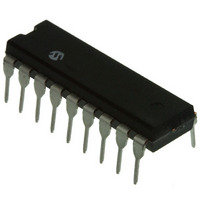PIC16F84A-20I/P Microchip Technology, PIC16F84A-20I/P Datasheet - Page 142

PIC16F84A-20I/P
Manufacturer Part Number
PIC16F84A-20I/P
Description
IC MCU FLASH 1KX14 EE 18DIP
Manufacturer
Microchip Technology
Series
PIC® 16Fr
Datasheets
1.PIC16F688T-ISL.pdf
(688 pages)
2.PIC16F84A-04P.pdf
(88 pages)
3.PIC16F84A-04P.pdf
(6 pages)
Specifications of PIC16F84A-20I/P
Program Memory Type
FLASH
Program Memory Size
1.75KB (1K x 14)
Package / Case
18-DIP (0.300", 7.62mm)
Core Processor
PIC
Core Size
8-Bit
Speed
20MHz
Peripherals
POR, WDT
Number Of I /o
13
Eeprom Size
64 x 8
Ram Size
68 x 8
Voltage - Supply (vcc/vdd)
4 V ~ 5.5 V
Oscillator Type
External
Operating Temperature
-40°C ~ 85°C
Processor Series
PIC16F
Core
PIC
Data Bus Width
8 bit
Data Ram Size
68 B
Maximum Clock Frequency
20 MHz
Number Of Programmable I/os
13
Number Of Timers
1
Operating Supply Voltage
2 V to 5.5 V
Maximum Operating Temperature
+ 85 C
Mounting Style
Through Hole
3rd Party Development Tools
52715-96, 52716-328, 52717-734
Development Tools By Supplier
ICE2000
Minimum Operating Temperature
- 40 C
Data Rom Size
64 B
Height
3.3 mm
Length
22.86 mm
Supply Voltage (max)
5.5 V
Supply Voltage (min)
4 V
Width
6.35 mm
Lead Free Status / RoHS Status
Lead free / RoHS Compliant
For Use With
I3-DB16F84A - BOARD DAUGHTER ICEPIC3DVA16XP180 - ADAPTER DEVICE FOR MPLAB-ICEAC164010 - MODULE SKT PROMATEII DIP/SOIC
Data Converters
-
Connectivity
-
Lead Free Status / Rohs Status
Lead free / RoHS Compliant
Available stocks
Company
Part Number
Manufacturer
Quantity
Price
Company:
Part Number:
PIC16F84A-20I/P
Manufacturer:
MICROCHIP
Quantity:
2 300
Part Number:
PIC16F84A-20I/P
Manufacturer:
MIC
Quantity:
20 000
- Current page: 142 of 688
- Download datasheet (3Mb)
PICmicro MID-RANGE MCU FAMILY
9.1
DS31009A-page 9-2
Introduction
General purpose I/O pins can be considered the simplest of peripherals. They allow the
PICmicro™ to monitor and control other devices. To add flexibility and functionality to a device,
some pins are multiplexed with an alternate function(s). These functions depend on which
peripheral features are on the device. In general, when a peripheral is functioning, that pin may
not be used as a general purpose I/O pin.
For most ports, the I/O pin’s direction (input or output) is controlled by the data direction register,
called the TRIS register. TRIS<x> controls the direction of PORT<x>. A ‘1’ in the TRIS bit corre-
sponds to that pin being an input, while a ‘0’ corresponds to that pin being an output. An easy
way to remember is that a ‘1’ looks like an I (input) and a ‘0’ looks like an O (output).
The PORT register is the latch for the data to be output. When the PORT is read, the device reads
the levels present on the I/O pins (not the latch). This means that care should be taken with
read-modify-write commands on the ports and changing the direction of a pin from an input to an
output.
Figure 9-1
be multiplexed onto the I/O pin. Reading the PORT register reads the status of the pins whereas
writing to it will write to the port latch. All write operations (such as BSF and BCF instructions) are
read-modify-write operations. Therefore a write to a port implies that the port pins are read, this
value is modified, and then written to the port data latch.
Figure 9-1: Typical I/O Port
WR PORT
WR TRIS
RD PORT
Data bus
Note: I/O pin has protection diodes to V
shows a typical I/O port. This does not take into account peripheral functions that may
Data Latch
TRIS Latch
D
CK
D
CK
RD TRIS
Q
Q
Q
Q
DD
and V
Q
SS
EN
.
D
V
V
P
N
DD
SS
1997 Microchip Technology Inc.
Trigger
Schmitt
TTL or
I/O pin
Related parts for PIC16F84A-20I/P
Image
Part Number
Description
Manufacturer
Datasheet
Request
R

Part Number:
Description:
Manufacturer:
Microchip Technology Inc.
Datasheet:

Part Number:
Description:
IC MCU FLASH 1KX14 EE 18DIP
Manufacturer:
Microchip Technology
Datasheet:

Part Number:
Description:
IC MCU FLASH 1KX14 EE 18SOIC
Manufacturer:
Microchip Technology
Datasheet:

Part Number:
Description:
IC MCU FLASH 1KX14 EE 18DIP
Manufacturer:
Microchip Technology
Datasheet:

Part Number:
Description:
IC MCU FLASH 1KX14 EE 18SOIC
Manufacturer:
Microchip Technology
Datasheet:

Part Number:
Description:
IC MCU FLASH 1KX14 EE 18DIP
Manufacturer:
Microchip Technology
Datasheet:

Part Number:
Description:
IC MCU FLASH 1KX14 EE 18SOIC
Manufacturer:
Microchip Technology
Datasheet:

Part Number:
Description:
IC MCU FLASH 1KX14 EE 20SSOP
Manufacturer:
Microchip Technology
Datasheet:

Part Number:
Description:
IC MCU FLASH 1KX14 EE 18SOIC
Manufacturer:
Microchip Technology
Datasheet:

Part Number:
Description:
IC MCU FLASH 1KX14 EE 20SSOP
Manufacturer:
Microchip Technology
Datasheet:

Part Number:
Description:
IC MCU FLASH 1KX14 EE 20SSOP
Manufacturer:
Microchip Technology
Datasheet:

Part Number:
Description:
IC MCU FLASH 1KX14 EE 20SSOP
Manufacturer:
Microchip Technology
Datasheet:

Part Number:
Description:
IC MCU CMOS 4MHZ 1K FLASH 18-DIP
Manufacturer:
Microchip Technology
Datasheet:

Part Number:
Description:
IC MCU CMOS 20MHZ 1K FLASH 18DIP
Manufacturer:
Microchip Technology
Datasheet:

Part Number:
Description:
IC MCU CMOS 4MHZ 1K FLASH 18SOIC
Manufacturer:
Microchip Technology
Datasheet:











